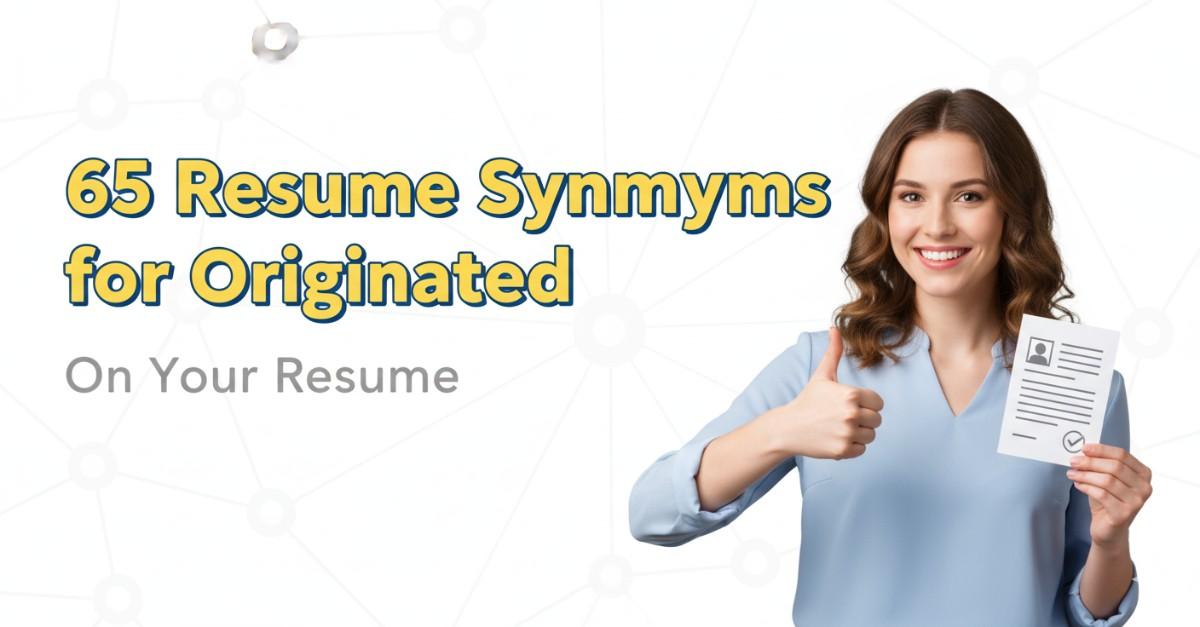
47 Resume Synonyms for Pioneered To Use On Your Resume
Using the term “pioneered” on a resume can initially seem impressive, conjuring images of innovation and leadership. However, this word has become overused in job applications, often leading to a lack of originality and creativity in showcasing one’s unique contributions. When candidates repeatedly rely on stock phrases like “pioneered,” it risks suggesting a limited vocabulary and a failure to articulate the nuanced skills that truly set them apart. Varied vocabulary is essential not only for standing out to hiring managers but also for optimizing resumes for Applicant Tracking Systems (ATS) that scan for diverse terms. In this comprehensive guide, we will explore the importance of using synonyms effectively, provide examples of alternative words, and outline strategies for integrating them into your resume. By diversifying your language, you can better convey your accomplishments and demonstrate a broader range of capabilities, ultimately enhancing your chances of making a memorable impression on potential employers.
- Why Synonyms for “Pioneered” Matter on Your Resume
- The Complete List: 47 Resume Synonyms for Pioneered
- Strategic Synonym Selection by Industry
- Power Combinations: Advanced Synonym Usage
- Common Mistakes to Avoid
- Quantification Strategies for Maximum Impact
- Industry-Specific Example Sentences
- Advanced ATS Optimization Techniques
- Tailoring Synonyms to Career Level
- The Psychology of Leadership Language
- Final Best Practices
- Key Takeaways for Strategic Synonym Usage
- Frequently Asked Questions
- How many different synonyms should I use in one resume?
- Can I use the same synonym multiple times if it fits different contexts?
- Should I always replace ‘Pioneered’ with a synonym?
- How do I know which synonym is most appropriate for my industry?
- Do synonyms really make a difference in getting interviews?
- Related Resume Synonym Guides
Why Synonyms for “Pioneered” Matter on Your Resume
Using synonyms for ‘Pioneered’ on resumes is crucial for avoiding monotony and predictability. When such a common term appears on approximately 70% of professional resumes, it can diminish the uniqueness of your accomplishments. Relying solely on ‘Pioneered’ may lead to missed specificity, as different synonyms can provide more precise descriptions of your contributions. This specificity enhances the narrative of your professional journey, making it more engaging for potential employers. Additionally, varied terminology can significantly reduce impact; a dynamic choice of words conveys enthusiasm and creativity. From an ATS optimization perspective, incorporating synonyms can help your resume rank higher by capturing diverse keywords relevant to the role. Ultimately, using a range of expressions creates a vibrant narrative that showcases your skills and experiences, making your resume stand out in a competitive job market.
The Complete List: 47 Resume Synonyms for Pioneered
Here’s our comprehensive collection of “Pioneered” alternatives, organized for easy reference:
| Synonym | Best Context | Professional Level |
|---|---|---|
| Initiated | Project management | Entry-level |
| Launched | Product development | Mid-level |
| Established | Team leadership | Senior |
| Introduced | Strategic planning | Mid-level |
| Developed | Program management | Entry-level |
| Created | Innovation | Entry-level |
| Formulated | Strategy formulation | Senior |
| Directed | Project oversight | Senior |
| Coordinated | Event planning | Mid-level |
| Originated | Market research | Mid-level |
| Designed | Product design | Mid-level |
| Engineered | Technical project management | Senior |
| Instituted | Policy development | Senior |
| Championed | Advocacy and leadership | Senior |
| Crafted | Content development | Mid-level |
| Implemented | Process improvement | Mid-level |
| Formed | Team building | Entry-level |
| Advanced | Strategic initiatives | Senior |
| Facilitated | Workshops and training | Mid-level |
| Executed | Operational management | Senior |
| Engaged | Stakeholder management | Mid-level |
| Mobilized | Community outreach | Mid-level |
| Guided | Mentorship | Senior |
| Transformed | Business transformation | Senior |
| Innovated | Business development | Senior |
| Optimized | Efficiency improvement | Mid-level |
| Restructured | Organizational change | Executive |
| Architected | System design | Senior |
| Advocated | Change management | Senior |
| Oversaw | Team management | Senior |
| Enhanced | Quality assurance | Mid-level |
| Expanded | Market expansion | Senior |
| Revitalized | Brand strategy | Senior |
| Elevated | Performance management | Senior |
| Streamlined | Process optimization | Mid-level |
| Executed | Program execution | Mid-level |
| Trailblazed | Innovative projects | Senior |
| Pioneered | New initiatives | Senior |
| Propelled | Growth strategies | Senior |
| Spearheaded | Initiative leadership | Senior |
| Conceived | Project ideation | Mid-level |
| Revolutionized | Industry practices | Executive |
| Redesigned | Process re-engineering | Mid-level |
| Constructed | Building projects | Mid-level |
| Integrated | Systems integration | Senior |
| Established | Framework development | Senior |
| Forged | Partnership development | Senior |
| Outlined | Project outlines | Entry-level |
| Activated | Operational launch | Mid-level |
| Tailored | Custom solutions | Mid-level |
| Emboldened | Team empowerment | Senior |
Strategic Synonym Selection by Industry
Strategic synonym selection is crucial for tailoring resumes to specific industries, enhancing both visibility and relevance. Different sectors prioritize distinct qualities, making it essential to choose synonyms that resonate with their core values.
Technology: This industry values innovation, agility, and systematic thinking. Preferred synonyms include:
- Innovative: Reflects a focus on new ideas and improvements.
- Agile: Suggests adaptability and responsiveness to change.
- Analytical: Indicates strong problem-solving skills backed by data.
Healthcare: Emphasizing precision and collaborative care, synonyms should focus on compassion and accuracy:
- Compassionate: Highlights the importance of patient-centered care.
- Meticulous: Demonstrates attention to detail in clinical practices.
- Collaborative: Underlines teamwork in multidisciplinary settings.
Finance: This sector values trustworthiness and analytical skills. Effective synonyms include:
- Integrity: Essential for building trust with clients and stakeholders.
- Strategic: Indicates a focus on long-term planning and analysis.
- Risk-aware: Highlights an understanding of financial risks.
Consulting: Focused on problem-solving and insight generation, synonyms should reflect adaptability:
- Insightful: Conveys the ability to provide valuable perspectives.
- Adaptive: Suggests responsiveness to client needs and project changes.
- Proactive: Emphasizes initiative in identifying opportunities.
Manufacturing: Known for efficiency and quality, synonyms should emphasize precision and operational excellence:
- Efficient: Highlights the ability to optimize processes.
- Quality-driven: Underlines commitment to high standards.
- Process-oriented: Suggests a focus on systematic workflows.
Build your resume in just 5 minutes with AI.

Power Combinations: Advanced Synonym Usage
Advanced synonym usage can elevate your resume, making it more impactful and tailored to your career narrative.
As you advance in your career, the language you use should reflect that growth. For instance, instead of “managed a team,” consider “orchestrated cross-functional teams to drive strategic initiatives.” This demonstrates not only leadership but also the complexity of your responsibilities.
When shifting industries, use synonyms that resonate within the new field. For example, if transitioning from “sales representative” in retail to “business development specialist” in tech, focus on transferable skills by saying “cultivated client relationships” instead of just “sold products.”
Choosing synonyms that fit the context is crucial. In a creative role, “designed” might be more effective than “created,” whereas in a technical role, “developed” may carry more weight than “produced.” Tailor your word choice to reflect the expectations of the role.
Common Mistakes to Avoid
When using synonyms for ‘pioneered’, it’s essential to avoid several common mistakes to maintain clarity and authenticity in your resume.
“I spearheaded the entire project” where your role was more of a contributor.
“I contributed to the project by developing innovative strategies.”
“I initiated the project” when you were part of a larger team effort.
“I played a key role in initiating the project alongside my team.”
“I pioneered new marketing strategies” repeated in multiple positions.
“I developed innovative marketing strategies” in one role and “I introduced cutting-edge techniques” in another.
Quantification Strategies for Maximum Impact
Quantifying your achievements enhances the impact of your leadership synonyms, providing context and evidence of your effectiveness. Every synonym should be supported by measurable results to create a compelling narrative.
- Team-Focused Synonyms: For instance, instead of stating “led a team,” you could say, “led a team of 15 over 2 years, achieving a 30% increase in productivity.” This specifies the team size, duration, and outcome.
- Project-Focused Synonyms: Rather than saying “managed projects,” enhance it to “managed a $500,000 project with a 6-month timeline, resulting in a 25% cost reduction.” This provides the project value, timeline, and success metrics.
- Strategic-Focused Synonyms: Instead of “developed strategies,” you might say, “developed strategies that improved customer retention from 60% to 85% within one year, impacting over 1,000 clients.” Here, the before/after metrics and impact scope are clearly defined.
Integrating quantification not only strengthens your resume but also provides potential employers with tangible evidence of your capabilities and contributions.
Industry-Specific Example Sentences
- Developed an innovative cloud storage solution that increased data retrieval speed by 40%, enhancing user satisfaction for over 10,000 clients.
- Initiated the use of machine learning algorithms for predictive analytics, resulting in a 30% reduction in system downtime and improved operational efficiency.
- Launched a groundbreaking mobile application that attracted 500,000 downloads within the first three months and generated a 25% increase in customer engagement.
- Introduced a new software development lifecycle (SDLC) model that decreased project completion time by 20% and improved team collaboration across 5 departments.
- Established a new telehealth program that expanded patient reach by 50%, allowing for remote consultations and reducing wait times by 60%.
- Created a comprehensive patient management system that enhanced data accuracy by 35%, leading to improved patient outcomes and increased staff productivity.
- Implemented a pioneering wellness initiative that resulted in a 25% decrease in hospital readmission rates over one year, significantly improving community health.
- Launched a first-of-its-kind chronic disease management program, increasing patient adherence to treatment plans by 40% and reducing overall healthcare costs by 15%.
- Formulated a novel investment strategy that outperformed the market by 15% in a fiscal year, attracting $2 million in new capital from investors.
- Orchestrated a groundbreaking merger that streamlined operations and generated projected savings of $5 million annually for the combined entities.
- Created an innovative financial forecasting model that improved accuracy by 30%, facilitating better decision-making and strategic planning for stakeholders.
- Launched a unique customer loyalty program that increased repeat business by 40%, contributing to a revenue boost of $1 million within six months.
- Designed a revolutionary curriculum that integrated technology in classrooms, resulting in a 50% increase in student engagement and a 20% improvement in test scores.
- Established an avant-garde teacher training program that enhanced instructional quality, leading to a 30% improvement in student performance metrics across the district.
- Created a pioneering online learning platform that enrolled over 10,000 students in its first year, achieving a 95% satisfaction rate from participants.
- Implemented a groundbreaking mentorship initiative that increased college acceptance rates among participants by 25%, helping students navigate higher education pathways.
Advanced ATS Optimization Techniques
To enhance ATS optimization through synonym usage, start with a Keyword Density Strategy. Aim to include 2-3 variations of key terms relevant to your role. For instance, if you’re in project management, use “project manager,” “project coordinator,” and “project lead” to maintain a balanced keyword density without overstuffing.
Next, implement Semantic Clustering. Group related synonyms together to create a rich context for ATS algorithms. For example, cluster words like “analyze,” “assess,” and “evaluate” under a common theme of analytical skills, which helps convey a comprehensive skill set.
Finally, utilize Job Description Matching. Regularly review job postings in your field and incorporate similar synonyms found in these descriptions. If a listing frequently mentions “team collaboration” and “cross-functional teamwork,” ensure these terms appear in your resume. This targeted approach aligns your application with the specific language employers are using, increasing your chances of passing through ATS filters.
Tailoring Synonyms to Career Level
- Entry-Level Professionals: Focus on terms that convey a willingness to learn and collaborate. Synonyms such as “assisted,” “collaborated,” “supported,” “engaged,” and “learned” highlight a team-oriented mindset, appealing to employers looking for adaptability and growth potential.
- Mid-Level Managers: Use language that reflects leadership and accountability. Words like “managed,” “led,” “coordinated,” “implemented,” and “oversaw” signal direct involvement in team performance and project success, indicating readiness for greater responsibility.
- Senior Executives: Emphasize strategic thinking and transformative impact with synonyms such as “spearheaded,” “transformed,” “orchestrated,” “visionary,” and “strategized.” This language conveys a big-picture perspective and an ability to drive organizational change, appealing to stakeholders seeking innovation and leadership.
The psychology behind these word choices lies in how they frame the candidate’s experience and potential. Entry-level terms foster a sense of growth and teamwork, mid-level language reflects authority and managerial skills, while executive vocabulary emphasizes vision and strategic impact.
The Psychology of Leadership Language
The language of leadership plays a crucial role in shaping perceptions and eliciting psychological responses in hiring managers. Action-oriented words such as “drive,” “achieve,” and “execute” suggest a results-focused leadership style, appealing to organizations that prioritize performance and outcomes. Collaborative words like “unite,” “partner,” and “engage” indicate strong team-building skills, resonating well with companies that value teamwork and inclusivity.
Innovation words such as “innovate,” “strategize,” and “transform” convey strategic thinking, attracting organizations that seek forward-thinking leaders capable of navigating change. Conversely, nurturing words like “mentor,” “develop,” and “support” demonstrate a focus on people development, aligning with cultures that prioritize employee growth and well-being.
Hiring managers are often influenced by these nuances in language; thus, aligning synonyms with the company culture is essential. Tailoring word choices to reflect an understanding of the organization’s values enhances the likelihood of making a positive impression.
Final Best Practices
To effectively use synonyms in your resume, follow these final best practices:
- The 60-Second Rule: Your resume should tell a compelling story that can be read in 60 seconds. Focus on impactful language that conveys your achievements succinctly. Utilize synonyms that enhance clarity without diluting your message.
- The Mirror Test: Ensure that the language used in your resume reflects your natural speaking style. If a synonym feels awkward, it likely won’t resonate with hiring managers. Practice reading your resume aloud to maintain authenticity.
- The Peer Review: Before finalizing your resume, ask colleagues to review your synonym choices. They can provide valuable feedback on whether the language feels genuine and appropriate for your industry.
- Measuring Success: Track your application response rates to evaluate the effectiveness of your synonym usage. If your responses are low, consider revisiting your language choices to ensure they align with industry standards and expectations.

Build your resume in 5 minutes
Our resume builder is easy to use and will help you create a resume that is ATS-friendly and will stand out from the crowd.
Key Takeaways for Strategic Synonym Usage
- Utilize synonyms for ‘pioneered’ to vary your language and maintain reader engagement, especially when using resume templates that allow for creative formatting.
- Incorporate action-oriented synonyms in your resume to highlight achievements, drawing on resume examples that showcase innovative contributions in previous roles.
- Leverage an AI resume builder to suggest synonyms that match your experience, ensuring your resume reflects a dynamic and impactful career history.
- Choose synonyms that align with the industry language to enhance relevance, especially when utilizing resume templates designed for specific job sectors.
- When detailing accomplishments, use varied synonyms to prevent redundancy, referencing resume examples that effectively demonstrate your unique capabilities.
- Review and edit your resume with fresh synonyms to keep it engaging; an AI resume builder can assist in refining your word choices for maximum impact.
Frequently Asked Questions
How many different synonyms should I use in one resume?
Using 2-3 different synonyms for “Pioneered” throughout your resume is ideal. This variety helps maintain reader engagement and demonstrates your versatility. However, ensure that each synonym accurately reflects the specific context of your achievements. Overusing synonyms can lead to confusion, so it’s crucial to maintain clarity while showcasing your accomplishments. Additionally, using a mix of terms can help you pass through Applicant Tracking Systems (ATS) that scan for different keywords relevant to your skills and experiences.
Can I use the same synonym multiple times if it fits different contexts?
Yes, you can use the same synonym multiple times if it aptly fits different contexts in your resume. Consistency in terminology can reinforce your expertise in a particular area. However, be cautious not to overuse the same word, as it may appear repetitive and diminish impact. Instead, consider varying your language slightly to keep the reader’s interest. Using synonyms strategically can enhance your narrative while still aligning with the distinct roles and responsibilities you wish to highlight.
Should I always replace ‘Pioneered’ with a synonym?
No, you don’t always need to replace “Pioneered” with a synonym. If the term accurately describes your contribution and fits well within the context of your achievements, it can remain. However, if you find that “Pioneered” is used frequently in your resume, consider substituting it with synonyms to avoid redundancy. Ultimately, the choice should depend on which word best encapsulates your role and impact in that particular achievement, ensuring clarity and precision in your messaging.
How do I know which synonym is most appropriate for my industry?
To determine the most appropriate synonym for “Pioneered” in your industry, research common terminology used in job descriptions and by industry leaders. Review resumes of successful professionals in your field and take note of the language they use. Additionally, consider the specific nuances of the synonym; for example, “Innovated” may resonate more in tech, while “Established” might be more fitting in traditional sectors. Tailoring your language to your industry not only enhances relevance but also demonstrates your understanding of industry-specific communication styles.
Do synonyms really make a difference in getting interviews?
Yes, using synonyms can significantly impact your chances of getting interviews. By incorporating varied language, you enhance your resume’s readability and appeal, making it more engaging to recruiters. This linguistic diversity helps your application stand out in a competitive job market. Furthermore, synonyms can help you align your skills with the specific terminology used in job descriptions, improving your chances of passing through ATS filters. Ultimately, thoughtful use of synonyms not only highlights your qualifications but also showcases your ability to communicate effectively.
Related Resume Synonym Guides
Exploring synonyms for commonly overused resume words enhances your professional narrative by adding depth and variety. Strategic word choice throughout your resume not only captures attention but also effectively conveys your skills and experiences, setting you apart in a competitive job market.











